University of Melbourne
The University of Melbourne is a public research university located in Melbourne, Australia. Founded in 1853, it is Australia's second oldest university and the oldest in Victoria.[8] Its main campus is located in Parkville, an inner suburb north of Melbourne's central business district, with several other campuses located across Victoria.
 | |
| Latin: Universitas Melburniensis[1][2][3] | |
| Motto | Postera Crescam Laude (Latin) |
|---|---|
Motto in English | "May I grow in the esteem of future generations" |
| Type | Public |
| Established | 1853 |
| Endowment | AU$1.335 billion |
| Chancellor | Allan Myers |
| Vice-Chancellor | Duncan Maskell[4] |
Academic staff | 4,631[5] |
| Students | 52,475[5] |
| Undergraduates | 26,751[5] |
| Postgraduates | 22,543[5] |
| 3,451[5] | |
| Location | , , 37.7963°S 144.9614°E |
| Campus | Urban (Parkville Campus) 36 hectares (0.4 km2)[6] |
| Affiliations | Universitas 21, Go8, APRU, ACU, Washington University in St. Louis McDonnell International Scholars Academy[7] |
| Website | unimelb |
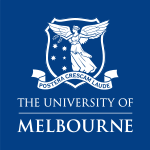 | |
Incorporated by the Victoria Colony, the University of Melbourne is one of Australia's six sandstone universities and a member of the Group of Eight, Universitas 21, Washington University's McDonnell International Scholars Academy,[9] and the Association of Pacific Rim Universities. Since 1872 various residential colleges have become affiliated with the university, offering accommodation for students and faculty, and academic, sporting and cultural programs. There are ten colleges located on the main campus and in nearby suburbs.
The university comprises ten separate academic units and is associated with numerous institutes and research centres, including the Walter and Eliza Hall Institute of Medical Research, Florey Institute of Neuroscience and Mental Health, the Melbourne Institute of Applied Economic and Social Research and the Grattan Institute. Amongst the university's fifteen graduate schools, the Melbourne Business School, the Melbourne Law School and the Melbourne Medical School are particularly well regarded.[10][11][12]
Times Higher Education ranked the University of Melbourne 32nd globally in 2020,[13] while the Academic Ranking of World Universities places it 41st in the world (both first in Australia).[14] In the QS World University Rankings 2021, the university ranks 41st globally[15]. Four Australian prime ministers and five governors-general have graduated from the University of Melbourne. Ten Nobel laureates have been students or faculty, the most of any Australian university.[16]
The university's coat of arms is a blue shield on which a depiction of "Victory" in white colour holds her laurel wreath over the stars of the Southern Cross. The motto, Postera crescam laude ("Later I shall grow by praise" or, more freely, "We shall grow in the esteem of future generations"), is written on a scroll beneath the shield. The Latin is from a line in Horace's Odes: ego postera crescam laude recens.
History
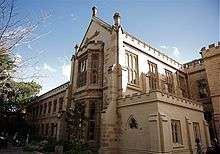
Foundations of the university

The University of Melbourne was established following a proposal by Hugh Childers, the Auditor-General and Finance Minister, in his first Budget Speech on 4 November 1852, who set aside a sum of £10,000 for the establishment of a university.[17] The university was established by Act of Incorporation on 22 January 1853, with power to confer degrees in arts, medicine, laws and music. The act provided for an annual endowment of £9,000, while a special grant of £20,000 was made for buildings that year.[18] The foundation stone was laid on 3 July 1854, and on the same day the foundation stone for the State Library[19] Classes commenced in 1855 with three professors and sixteen students; of this body of students only four graduated. The original buildings were officially opened by the Lieutenant Governor of the Colony of Victoria, Sir Charles Hotham, on 3 October 1855.
A law school was established in 1857 at the Parkville campus, following which a Faculty of Engineering and School of Medicine were established in 1861 and 1862 respectively. The university's residential colleges were first opened on the northern aspect of the campus in 1872, divided between the four main Christian denominations.[20]
The first chancellor, Redmond Barry (later Sir Redmond), held the position until his death in 1880. The inauguration of the university was made possible by the wealth resulting from Victoria's gold rush. The institution was designed to be a "civilising influence" at a time of rapid settlement and commercial growth.[21] In 1881, the admission of women was a seen as victory over the more conservative ruling council.[22] Julia 'Bella' Guerin graduated with a Bachelor of Arts in 1883, and became the first woman to graduate from an Australian University.[20]
1900s – 1970s
Early in the 1900s the university expanded its offerings to more utilitarian courses. In 1901 the number of students enrolled at the University of Melbourne exceeded 500 students for the first time. The university established the Diploma of Education in 1903, following negotiations with the Victorian Education Department. Despite the economic depression of the 1890s and the discovery of a significant fraud by a university registrar in 1901, the university continued to expand during this period. This growth included the construction of several buildings between 1900 and 1906. Such growth was facilitated largely through an increased government funding allocation, and the coinciding university led funding campaign. To accompany the training dentists received by the Melbourne Dental Hospital, a School of Dentistry was established to teach the scientific basis of dentistry at the university. Agriculture was established in 1911 following the appointment of the State Director of Agriculture as the first professor. During this period the university became a notable site for research, emerging as a leader in Australia. Following World War II the demand for higher education increased rapidly, and as a result became a transformative period for the university.[23]
1980s – present
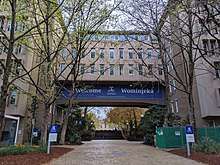
Expansion of the university increased significantly during the 1980s and 1990s, as the university amalgamated with a number of tertiary colleges. In 1988 the Melbourne Teachers' College was brought into the Faculty of Education, and the amalgamation lead to the formation of a distinctly new Faculty of Education. The College of Advanced Education was incorporated into the university in 1989. During this period, more students than ever had before attended the university. The university had expanded its student population to beyond 35,000 students. Such amalgamations continued into the 1990s, with the Victorian College of the Arts affiliation with the University of Melbourne in 1992. This grew the number of campuses for the University of Melbourne, which would now include a new St Kilda Road location.
In 2001, the Melbourne School of Population Health was established, the first of its kind in Australia, and continued the growth of the university. Work at the centre involved contributions from a many disciplines, ranging from the social sciences to epidemiology. Health fields such as Indigenous, women's, mental, sexual, and rural health have all been researched at the centre. A significant change in curriculum was established in 2008. The newly created model for education was developed, known at the university as The Melbourne Model. In this curriculum model, students firstly undertake a general bachelor's degree before specialising in either a professional or research graduate course.[23]
The university's 150th anniversary was celebrated in 2003.[24]
The Melbourne School of Land and Environment was disestablished on 1 January 2015. Its agriculture and food systems department moved alongside veterinary science to form the Faculty of Veterinary and Agricultural Sciences, while other areas of study, including horticulture, forestry, geography and resource management, moved to the Faculty of Science in two new departments.
Today over 8900 academic and professional staff support the more than 52,000 strong student population. The student population consists of more than 13,000 international students, from more than 130 countries.[23]
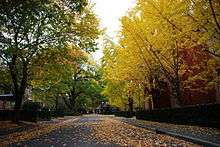
Campuses
The university has three other campuses in metropolitan Melbourne at Burnley, Southbank, and Werribee. The Burnley campus is where horticultural courses are taught.[25] Performing arts courses are taught at the Southbank campus. Veterinary science is taught at the Werribee campus.
In regional Victoria, the Creswick and Dookie campuses are used for forestry and agriculture courses respectively.[26][27] They previously housed several hundred residential students, but are now largely used for short courses and research. The Shepparton campus is home to the Rural Health Academic Centre for the Faculty of Medicine, Dentistry and Health Sciences.
The university is a part-owner of the Melbourne Business School, based at Parkville campus, which ranked 46th in the 2012 Financial Times global rankings.[28]
Parkville
The Parkville campus is the primary campus of the university.[29] Originally established in a large area north of Grattan Street in Parkville, the campus has expanded well beyond its boundaries, with many of its newly acquired buildings located in the nearby suburb of Carlton.[30] The university is undertaking an "ambitious infrastructure program" to reshape campuses.[31] The campus was founded in 1853, and is located just north of Melbourne's central business district. Parkville campus has cafes, gyms, 12 libraries, specialty stores, a small supermarket, and a seasonal farmers market. The campus is located within a broader renowned knowledge precinct, which encompasses eight hospitals, and many other leading research institutes.[32]
Several of the earliest campus buildings, such as the Old Quadrangle and Baldwin Spencer buildings, feature period architecture. The old quad underwent extensive restoration in 2019 to return to original design, including a dedicated temporary exhibition space in the Treasury Gallery.[33] The new Wilson Hall replaced the original building which was destroyed by fire.[34][35][36]
The Parkville campus was used extensively to shoot interior and exterior scenes in the MIFF-funded The Death and Life of Otto Bloom starring Twilight actor Xavier Samuel and Golden Globe nominee Rachel Ward.[37]
Southbank
The Southbank campus is home to the Victorian College of the Arts, and is situated within Melbourne's creative arts precinct. Sound and dance stages, animation studios, visual arts studios, and cinemas are all located at the university's purpose-built creative arts home.[32]
As of May 2009 the university "suspended" the Bachelor of Music Theatre and Puppetry courses at the college and there were fears they may not return under the new curriculum.[38]
A 2005 heads of agreement over the merger of the VCA and the university stated that the management of academic programs at the VCA would ensure that "the VCA continues to exercise high levels of autonomy over the conduct and future development of its academic programs so as to ensure their integrity and quality" and also that the college's identity will be preserved.[39] New dean Sharman Pretty outlined drastic changes under the university's plan for the college in early April 2009.[40] As a result, it is now being called into question whether the university have upheld that agreement.
Staff at the college responded to the changes, claiming the university did not value vocational arts training, and voicing fears over the future of quality training at the VCA.[41] Former Victorian arts minister Race Mathews has also weighed in on the debate expressing his hope that, "Melbourne University will not proceed with its proposed changes to the Victorian College of the Arts", and for 'good sense' to prevail.[42]
In 2011, the Victorian State Government allocated $24 million to support arts education at the VCA[43][44] and the faculty was renamed the Faculty of the Victorian College of the Arts and the Melbourne Conservatorium of Music.
A$200 million major capital works project at the campus is set for completion mid-2020. The project includes then construction of a new state-of-the-art conservatorium for musicians and the conversion of historically important buildings for use as future-ready training facilities.[45]
Burnley
The Burney Campus is located within the suburb of Burnley in Melbourne, around 5 km east of the Melbourne CBD.[46] The campus is dedicated to both ornamental and environmental horticulture, and is surrounded by nine hectares of heritage-listed gardens.[32] The campus began operating as a learning precinct in horticultural education in 1891. At the campus, students are offered short courses, associate degrees, post-graduate studies, and research. Specifically, training for urban landscape management, landscape design and production, park management, turf management, nursery and cut flower production, and arboriculture are all specialisations of the campus.[46]
Creswick
The Creswick campus is located within the township of Creswick, 120 km north-west of Melbourne. It is situated on 15 hectares of land, in is also connected native and plantation forests. Accommodation is available at the campus to members of the University of Melbourne's student cohorts and teaching staff when engaged at Creswick.[47] Creswick campus has been offering forest science education since 1910, and is Australia's only dedicated forest ecosystem science campus, which focuses on forest industry, conservation, and molecular biology research.[32] Scientists based at the campus include hydrologists, soil scientists, plant geneticists, geomorphologists, fire scientists, ecologists, engineers, and mathematicians.[47]
Dookie
The Dookie campus has been the university's rural home to agriculture and agricultural teaching and learning since its inception in 1886.[32] It is based between Shepparton and Benalla, about 220 km north east of Melbourne. Dookie campus is situated on 2440 hectares of land that houses student and staff accommodation, an orchard, winery, merino sheep, robotic dairy, and a natural bush reserve. Agriculture students are able to access the city campus in addition to a semester at the Dookie campus. Subjects in agriculture, science, commerce, and environments are available at the campus.[48]
Shepparton
The Shepparton Medical Centre campus is located in Shepparton, nearly 200 km north of Melbourne. The campus is part of the Melbourne Medical School, and the Shepparton base is home to the Shepparton Rural Clinical School. It provides fully furnished, subsidized, self-catered student on site at the Clinical School.[49] The University of Melbourne Shepparton Medical Centre was the first purpose built teaching clinic in Australia, and services Shepparton and surrounds with comprehensive primary healthcare.[50]
Werribee
The Werribee campus is located about 30 km south west of the city, and is home to research and teaching for the Melbourne Veterinary School.[51] Recently the campus undertook an AU$63 million redevelopment to enhance facilities for pet treatment and the training of future veterinarians at the University of Melbourne. Victoria's only accredited veterinary course is based at The University of Melbourne, at both the Werribee and Parkville campuses.[51] Kendall Hall offers self-catered accommodation for 76 residents in single bedrooms with shared facilities at the University of Melbourne Werribee campus.[52]
Organisation and administration
Governance
Governance of the university is grounded in an act of parliament, the University of Melbourne Act 2009.[53] The peak governing body is the "Council" the key responsibilities of which include appointing the vice-chancellor and principal, approving the strategic direction and annual budget, establishing operational policies and procedures and overseeing academic and commercial activities as well as risk management. The chair of the council is the "chancellor". The "academic board" oversees learning, teaching and research activities and provides advice to the council on these matters. The "committee of convocation" represents graduates and its members are elected in proportion to the number of graduates in each faculty.[54]
The University of Melbourne's operations are governed through a hierarchy of delegations framework. A 13-member council is the university's governing body. It establishes the university's council, determines its core functions, and allows the university to enact subordinate legislation through statutes and regulations. Under legislative elements associated with the council, university policies exist as a formal statement of principle to regulate university operations. Under university policies, university processes exist to support workplace agreements, policy, and relevant legislation by noting day-to-day operation tasks and activities to be performed by staff.[55]
The academic board is held responsible to the council for quality assurance in activities such as the maintenance of high standards in teaching, research and learning. The University of Melbourne Executive is the university's principal management committee. The university consists of academic and administrative structures. University leadership encompasses the chancellor, vice-chancellor and senior executives, who are responsible for the strategic vision of the university.[56]
Endowment
The University of Melbourne has an endowment of approximately $1.335 billion,[57] the largest of any Australian tertiary institution. However, Australian endowments are relatively small compared with those of the wealthiest US universities.
The university's endowments recovered after hardship following the 2008 Great Recession, which shrank its investments by 22%. This required restructuring of the university, including cutting of some staff, largely through redundancies and early retirements.[58] A further round of cuts, driven by lingering concerns about finances and declining Federal contributions to the tertiary sector, took place under the 'Business Improvement Program'(BIP) from 2014–16 and involved another 500 jobs.[59]
Under former vice-chancellor Glyn Davis, the university publicly launched Believe – the Campaign for the University of Melbourne in 2013. The campaign's goal was to raise $500 million by the end of 2017. With more than 20,000 international donors, the university reached its target two years ahead of schedule. In March 2016, Davis launched the second phase of the campaign. Phase two aims to raise a total of $1 billion by 2021, and to engage 100,000 alumni in the process.[60]
Faculties and present deans
The University of Melbourne is divided into 10 faculties, which encompass all major departments of both research and teaching.[61]
- Faculty of Architecture, Building and Planning: Julie Willis.[62]
- Faculty of Arts: Russell Goulbourne.[63]
- Faculty of Business and Economics: Paul Kofman and Ian Harper (co-deans).[64]
- Melbourne Graduate School of Education: Jim Watterston.[65]
- Melbourne School of Engineering: Mark Cassidy.[66]
- Faculty of Fine Arts and Music: Barry Conyngham.[67]
- Melbourne Law School: Pip Nicholson.[68]
- Faculty of Medicine, Dentistry and Health Sciences: Shitij Kapur.[69]
- Faculty of Science: Karen Day.[70]
- Faculty of Veterinary and Agricultural Sciences: John Fazakerley.[71]
Academic profile
Admissions
The university has 11 academic units,[72] some of which incorporate a graduate school. The overall attrition and retention rates at the university are the lowest and highest respectively in Australia.[73] The university has one of the highest admission requirements in the country, with the median ATAR of its undergraduates being 94.05 (2009).[74] Furthermore, the university continued to attract outstanding students; for example, 50% of the Premier's VCE Top All-Round High Achievers enrolled at the University of Melbourne.[74]
For domestic applications, an Australian Tertiary Admission Rank (ATAR) is generally required for bachelor's degrees. For undergraduate degrees in 2019, guaranteed entry scores into degrees were: Agriculture 70, Arts 85, Biomedicine 96, Commerce 94, Design 85, Science 85, Oral Health 85 (indicative only), Fine Arts and Music were not applicable.[75]
Domestic applicants who have a disadvantaged financial background, are from rural or isolated areas, are from under represented schools, experienced difficult circumstances, have a disability or medical condition, are from a non-English speaking background, identify as an Indigenous Australian, or are applying through a non-school leaver entry pathway may be eligible for the Access Melbourne program.[76] The program offered guaranteed entry in 2019 for students with ATARs of: Arts 80, Biomedicine 92, Commerce 88, Design 78, and Science 78.[77]
Minimum International Baccalureate Diploma scores for undergraduate guaranteed entry were: Agriculture 25, Arts 31, Biomedicine 38, Commerce 36, design 31, Science 31, Oral Health 31 (indicative only), Fine arts and Music were not applicable.[75]
Teaching and learning
The University of Melbourne is unlike any other university in Australia so far as it offers nine generalised three-year degrees instead of more traditional specialized undergraduate degrees:[78]
- Bachelor of Arts
- Bachelor of Agriculture
- Bachelor of Biomedicine
- Bachelor of Commerce
- Bachelor of Design
- Bachelor of Fine Arts
- Bachelor of Music
- Bachelor of Oral Health
- Bachelor of Science
The Bachelor of Design was a new addition that begun in 2017; this corresponded with the closure of the Bachelor of Environments (2008-2016), which was controversially axed in 2016 against the wishes of several participating Departments wishing to retain an environmental focus.[79] The change from the former curriculum, which offered many single and joint degrees, is often described as the "Melbourne Model", and was implemented under the leadership of Vice-Chancellor Glyn Davis in 2008. The university also offers postgraduate courses (including professional-entry master's degrees) that follow undergraduate courses with greater specialization.[80] in the early 2000s, which offers an innovative cross-Faculty environmental master's degree[81]
As of 2007, Melbourne University aimed to offer 75% of graduate places as HECS (with the remaining 25% paying full fees).[82]
A number of professional degrees are available only for graduate entry. These degrees are at a masters level according to the Australian Qualification Framework,[83] but are named "masters" or "doctorate" following the practice in North America.
Various groups, including trade[84] and student unions,[85] [86] [87] academics,[88] [89] and some students[90][91] have expressed criticism of the Melbourne Model, citing job and subject cuts, and a risk of "dumbing down" content. A group of students also produced a satirical musical regarding the matter. The Model has been subject to internal review, with the shift from the B Environments to B Design being one result.
Rankings
| University rankings | |
|---|---|
| University of Melbourne | |
| QS World[92] | 41 |
| THE-WUR World[93] | 32 |
| ARWU World[94] | 41 |
| USNWR World[95] | 26 |
| CWTS Leiden World[96] | 34 |
| Australian rankings | |
| QS National[92] | 2 |
| THE-WUR National[97] | 1 |
| ARWU National[98] | 1 |
| USNWR National[99] | 1 |
| CWTS Leiden National[96] | 2 |
| ERA National[100] | 1 |
When averaging the world's major rankings, the University of Melbourne (40) appears to be ranked first in Australia, ahead of the second-ranked University of Queensland (47).
Times Higher Education ranked Melbourne 32nd globally (1st nationally) in the 2017-2018 iteration of its annual World University Rankings.[101] In the QS World University Rankings 2019,[102] the University of Melbourne was ranked 39th globally (2nd in Australia). In 2019, it ranked 31st among the universities around the world by SCImago Institutions Rankings.[103] In the most recent CWTS Leiden Ranking, Melbourne was ranked 33rd in the world (2nd nationally).[104] The university was ranked 38th globally (1st in Australia) in the 2018 publication of the Academic Ranking of World Universities (ARWU) league table.[105] According to QS World University Subject Rankings 2015,[106] the University of Melbourne is ranked 5th in the world for education, 8th in law, 13th in computer science and IT, 13th in arts and humanities,[107] 14th in accounting and finance, 14th in dentistry and 18th in medicine.
Research
Melbourne University claims that its research expenditure is second only to that of the Commonwealth Scientific and Industrial Research Organisation (CSIRO).[108] The university is a leading Australian research university, with the largest cohort of research students in Australia.[109]
The Performance Ranking of Scientific Papers for World Universities is released by National Taiwan University (NTU Ranking), and placed the University of Melbourne as the 29th highest internationally and 1st domestically in 2018.[110] It evaluates the performance of scientific papers, and the indicators used are designed to compare both the quantity and quality of published scientific works by each university.[111]
Similarly, the Center for World University Rankings (CWUR) ranks universities on variables, including both research output and citations.[112] For 2018/19 it ranked the University of Melbourne at number 57 in the world, and number 1 within Australia.[113]
The university is connected to more than 100 research centres and institutes.[114] In 2010 the university spent $813 million on research.[115] In the same year the university had the highest numbers of federal government Australian Postgraduate Awards (APA) and International Postgraduate Research Scholarships (IPRS),[116] as well as the largest totals of Research Higher Degree (RHD) student load (3,222 students) and RHD completions (715).[117]
An extensive profile of the research activity of the University and its researchers is maintained on the University of Melbourne Find an Expert system. It currently lists more than 8500 active researchers.
Entrepreneurship and innovation
The Melbourne Entrepreneurial Centre (MEC) is the university's entrepreneurial arm.[118] MEC offers students, alumni and the general public access to the entrepreneurial opportunities available at the university, including hackathons, accelerators, pitch nights, masterclasses, workshops and programs. The MEC overarches the Melbourne Accelerator Program (MAP), Translating Research at Melbourne (TRaM) and the Wade Institute of Entrepreneurship.[119]
Melbourne Accelerator Program
Since its inception in 2012, MAP has evolved into a program which hosts a range of public events, workshops and feeder programs to help up-skill and connect entrepreneurs of all stages.[120] The best startups on campus are awarded access to the MAP Startup Accelerator. In 2014, MAP was one of two Australian university accelerators that have been named in a global list of top 25 university incubators produced by University Business Incubator Index.[121] The first MAP cohort in 2012 includes Bluesky,[122] 121 Cast,[123] VenueMob[124] and New Wave Power Systems. Notably, Bluesky managed to enter the finals of the StarTrack Online Retail Industry Awards 2014[125] for best mobile shopping app against large Australian e-commerce incumbents including The Iconic and 121Cast signed a large content partnership contract with Southern Cross Austereo.[126] MAP student founders have collectively raised over $5.6 million in funding, created more than 60 jobs and generated over $1.0 million in revenue.[127] They tackle big problems across a range of industries, from medical devices and hardware, to financial technology, web solutions, e-commerce and software.
Translating Research at Melbourne (TRaM)
Translating Research at Melbourne (TRaM) is the University of Melbourne's research-based accelerator program. The program launched in 2016 and has seen more than 11 teams complete the program with many reaching commercial success. It offers university and affiliated researchers an opportunity to commercialise their research-based product or service through bootcamps and a dedicated training program.[128]
Wade Institute of Entrepreneurship
Wade Institute of Entrepreneurship is the university's hub for entrepreneurial training. The institute is home to the university's Master of Entrepreneurship, in addition to other programs, events and custom masterclasses. The institute is based at Ormond College, one of the university's residential colleges.[129]
Libraries
The University of Melbourne's libraries have over three million visitors performing 42 million loan transactions every year.[130] The general collection comprises over 3.5 million items including books, DVDs, photographic slides, music scores and periodicals as well as rare maps, prints and other published materials.[130] The library also holds over 32,000 e-books, hundreds of databases and 63,000 general and specialist journals in digital form.[130]
Architecture, Building and Planning Library
The Architecture, Building and Planning Library is located on the ground floor of the Melbourne School of Design Building located on the Parkville campus. Its collection consists primarily of works related to the faculty, including works of individual architects and firms, building types and local history.[131]
Baillieu Library
The Baillieu Library is located on the west side of the Parkville campus and is the university's largest discipline library. It has five levels, including an accessible basement. Completed in 1959, it was Australia's first purpose-built university library.
The Baillieu Library's collections are central to teaching, learning and research in the arts, humanities and social sciences, supporting the activities of undergraduates, postgraduates, academics and researchers. It is home to the University Library's Special Collections, which include rare books, rare music and the print collection. The reading room serves as the access point for special collections material, as well as for the University of Melbourne Archives and the Grainger Museum collection.[132]
Brownless Biomedical Library
The Brownless Biomedical Library is located within the Parkville campus behind the Medical Building, on the Grattan Street/Royal Parade perimeter of the campus. The library offers access to print and online collections including the Medical History Museum. Additionally, access to room and computer bookings, borrowing, printing, photocopying, scanning, and research consultations are all offered by the library.[133] Brownless Biomedical Library has a veterinary science collection in the areas of anatomy, physiology, microbiology, pharmacology, and animal health.[134]
Burnley Science Library
The Burnley Science Library is located at the Burnley campus and offers specialist resources for teachers and researchers, with collections on horticulture and the plants sciences. The library provides a user focused experience which invites student collaboration and study. It services the students of horticulture, and staff and researchers from the School of Ecosystem and Forest Science.[135] A general books collection, laboratories for fundamental research collection, reference collection, reserve collection, periodicals collection, rare books collection, videos collection, and compactus containing theses are available at the library.[136] The services on offer at the library include: borrowing, membership, renewals, inter-library loans, inter-campus loans, CAVAL and national borrowing scheme, Reserve, BONUS+ borrowing scheme, disability services, reference appointments, reference inquiries, and student IT support.[137]
Dookie Library
The Dookie Library is located at the Dookie campus and offers a specialist collection tailored to the Faculty of Veterinary and Agricultural Sciences.[138] Its collection includes books, periodicals and audio-visual collections. The collection covers areas of general agriculture; animal, plant and crop science; water resources; and wine and viticulture.[139] Services on offer at the Dookie Library are borrowing, membership, renewals, inter-library loans inter-campus loans, CAVAL and national borrowing scheme, Reserve, BONUS+ interstate borrowing scheme, exam papers, reference appointments, and reference enquiries.[140]
Eastern Resource Centre
The Eastern Resource Centre (ERC) is located on the east side of the Parkville campus, close to Grattan and Swanston streets. Its collection supports the needs of undergraduates, postgraduates, and researchers in both The Melbourne School of Engineering and the Faculty of Science.[141] Its collections encompass science and engineering, reference collections, East Asian collection, a map collection, high use collection, science engineering journal collections, and DVDs and other media.[142] The ERC includes a collection of resources for general agriculture; plant, animal and crop science, water resources; and wine and viticulture.[143] A full range of services are offered at the Eastern Resource Centre such as BONUS+ borrowing scheme, borrowing, CAVAL and National borrowing scheme membership, high use collection, inter-campus loans, inter-library loans, membership, photocopying and printing, project rooms, renewals, research consultations, student PCs, and disability services.[144]
Giblin Eunson Library
The Giblin Eunson library is located within the Faculty of Business and Economics Building at the university's Parkville campus. It is home to the faculty of Business and Economics as well as the Education faculty.[145] Broadly, the Giblin Eunson library offers project rooms, research consultations, eLearning studios, BONUS+ borrowing schemes, borrowing, CAVAL and national borrowing scheme membership, inter-campus loans, inter-library loans, renewals, high use collection, membership, printing and scanning, student IT support, and student PCs.[146] For Education students, the collection offers school level text books, picture books, junior fiction, children's literature award winners, kit collection, DVDs, videocassettes, CDs, CD-ROMs, pictures and posters, journals, references, and education theses.[147] Extensive research databases are accessible for Business and Economics students including academic journals, company databases, industry databases, country databases, and news databases.[148]
Law Library
The Law Library is located on levels 3, 4 and 5 of the Melbourne Law School at the university's Parkville campus. It is home to the Melbourne Law School.[149] The mission of the Law Library is to support learning and teaching at the Melbourne Law School (MLS) and to support academic research.[150] The library offers research tools that include authorised law reports, Australian Case Citator Comparison, deep linking information, keeping up to date in law, legal abbreviations, legal citation style guides, reference management, style guides for authors, and theses advice.[151] The catalogue of books at the library encompasses new books, a rare book collection, past exams and readings online, and a digital repository.[150]
Science Creswick Library
The Science Creswick Library is located at the Creswick campus and offers a specialist collection for the School of Ecosystem and Forest Science.[152] The services on offer at the library include: borrowing, memberships, renewals, inter-library loans, inter-campus loans, CAVAL and national borrowing scheme, Reserve, BONUS+ borrowing scheme, reference appointments, and reference enquiries.[153] Its collections include monographs, periodical collection, and the Creswick special collection. Areas covered in the collection are forest and plantation hydrology, community forestry, fire ecology and management, forest industries and wood products, forests, climate change and greenhouse research, native forest ecology and restoration, tree developmental biology and forest biotechnology, tree plantations and health, and tree ecophysiology.[154]
Southbank Library
The Southbank Library supports the Faculty of Fine Arts and Music at the Southbank Campus. It is a new library, that reopened in February 2019 following the Melbourne Conservatorium of Music moving the majority of its programs to the campus in the same year.[155] Services offered at the Southbank Hub (the home of the Southbank Library) include academic skills, bookable spaces and computers, careers and employability, counselling and psychological services, course planning, creative art therapies, research consultations, scholarships, study overseas, study equity and disability support, student health checks, and student IT.[156] Services offered at the library specifically include reference inquiries, research consultations, borrowing and renewals, membership for alumni and members of the public, inter-library loans, inter-campus copy service, CAVAL and national borrowing scheme, high use collections, BONUS+ borrowing scheme, disability support services, and copying and scanning.[157]
Veterinary Science Library Werribee
The Veterinary Science Library Werribee is based at the university's Werribee campus, and supports teaching, learning and research activities of those within the faculty. Generally the library collects in the areas of surgery, pathology and parasitology.[158] Services offered at the library include borrowing, membership, renewals, inter-library loans, inter-campus loans, BONUS+ borrowing scheme, and printing and scanning.[159]
Museums
Grainger Museum
The Grainger Museum is located at the university's Parkville campus, and is the only purpose built autobiographical museum in Australia. It is home to a diverse collection of over 100,000 items including photographs, costumes, art, music scores and instruments. The items were acquired by Percy Grainger, an icon in twentieth century Australian musical culture.[160]
Harry Brookes Allen Museum of Anatomy and Pathology
The Harry Brookes Allen Museum of Anatomy and Pathology, located at the Parkville campus, is one of Australia's largest collections of both historical anatomical models and real human tissue specimens. It provides students at The University of Melbourne educational resources for the medical and related anatomical disciplines. The museum is not normally open to the public, though tours of the museum are available for medical students and health professionals.[161]
Henry Forman Atkinson Dental Museum
The Henry Forman Atkinson Dental Museum is located at the Melbourne Dental School on the Parkville campus. It is the oldest dental collection in Australia, with over 3500 objects, photographs, documents, and catalogues. The museum aims to inspire, engage, and educate audiences about the changes in dentistry through time, and is unique in Australia due to its age and comprehensiveness.[162]
Ian Potter Museum of Art
The Ian Potter Museum of Art is located at the university's Parkville campus, and is the university's art museum. Since being founded in 1972, the museum has hosted more than 500 exhibitions. The Potter's collection exceeds 16,000 objects, with works ranging from antiquity to contemporary art. Exhibitions and associated programs have supported artists, curators, academics and writers in contributing to the university community as well as the city of Melbourne, and state of Victoria more broadly.[163]
Margaret Lawrence Gallery
The Margaret Lawrence Gallery is located at the university's Southbank campus in the heart of Melbourne's Arts Precinct. It provides a space for members of the Victorian College of the Arts community to showcase new work, playing an educational role for the institution. The gallery was opened in 2001 to link the Victorian College of the Arts with the University of Melbourne, and to the wider communities of Victorian and national arts. The space facilitates and encourages connections between professional artists, academics, students, and the wider public.[164]
Medical History Museum
The Medical History Museum is located within the Brownless Biomedical Library at the university's Parkville campus. The purpose of the museum is to encourage appreciation and understanding of the history of medicine and its role in society by facilitating direct engagement with its collections. Exhibitions and educational programs are offered by the museum to encourage inquiry in the medical field.[165]
Noel Shaw Gallery
The Noel Shaw Gallery is located within the Baillieu Library at the university's Parkville campus. It opened in 2014, following a bequest by university alumna, Noel Shaw. Each year two exhibitions are presented in the Noel Shaw Gallery, which focus on the opportunities for curriculum engagement.[166]
Ed Muirhead Physics Museum
The Ed Muirhead Physics Museum is located at the university's Parkville campus in the School of Physics building. The museum is named in honour of Ed Muirhead, who was the Chairman of the School of Physics from 1980 to 1986, and initiated the museum during that time. The collection comprises items that are of historical and scientific interest, predominantly scientific apparatus constructed by former professors and staff for research purposes.[167]
Dax Centre
The Dax Centre is located at the university's Parkville campus in the Kenneth Myer Building. The centre is named after Eric Cunningham Dax, who pioneered the use of art to promote clinical insights and mental health improvements. The centre is a leader in the use of art in raising awareness and reducing the stigma associated with mental illness. Exhibitions and educational programs hosted by the centre seek to engage, inform, and encourage community connections and conversations about mental health. The Dax Centre consists of educational programs and a gallery space and also houses the Cunningham Dax Collection.[168]
Tiegs Museum
The Tiegs Museum is located at the university's Parkville campus in the BioSciences building. The museum hosts a collection of zoological specimens accumulated over 120 years, and is named after a former professor and faculty dean, Oscar Tiegs. Specimens included in the collection range from small invertebrates to the whole mounts and skeletons of vertebrates including an African Lion, and a moa (an extinct emu-like bird from New Zealand).[169]
Buxton Contemporary
Buxton Contemporary is an art museum located at the university's Southbank campus, in Melbourne's Arts precinct. The museum was opened in 2018 and comprises four public exhibition galleries, teaching facilities and an outdoor screen for moving image art. The museum was the result of a gift to the university by the art collector and property developer Michael Buxton.[170]
Science Gallery
Science Gallery Melbourne will open in 2020 at the university's Parkville campus and will explore the collision between art and science. The gallery forms part of the Global Science Gallery Network and intends to provide a new model for engaging 15-25-year olds with science. It forms part of a new innovation precinct being developed by the university.[171]
Student life
Residential colleges
Melbourne University currently has 10 residential colleges in total, seven of which are located in an arc around the cricket oval at the northern edge of the campus, known as College Crescent. The other three are located outside of university grounds.
- Trinity College: 1872–present
- Ormond College: 1881–present
- Janet Clarke Hall: 1886–present
- Queen's College: 1887–present
- Newman College: 1918–present
- St Mary's College: 1918–present
- Medley Hall: 1954–present
- University College: 1937–present
- International House: 1957–present
- St Hilda's College: 1964–present
The residential colleges aim to provide accommodation and holistic education experience to university students.[172] Most of the university's residential colleges also admit students from RMIT University and Monash University, Parkville campus, with selected colleges also accepting students from the Australian Catholic University and Victoria University.
Graduate House (1972-) is a residential college for graduates located in Parkville's graduate precinct, which began its affiliation with the university in 1972.[173] Whitley college (1965-2017) was a former college of the university, though was sold to redeveloper in 2016.[174] Ridley College (1965-2005) was an affiliated residential college of the University of Melbourne and was the first college of the university to be co-residential for men and women.[175]
 Trinity College
Trinity College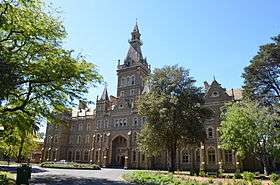 Ormond College
Ormond College.jpg) Janet Clarke Hall
Janet Clarke Hall.jpg) St Mary's College
St Mary's College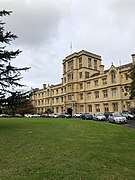 Queen's College
Queen's College- Newman College
 Medley Hall
Medley Hall
Faculty clubs and societies
Clubs and societies offered by the university range from cultural, course-related, political, language exchange, spiritual and community focuses.[176] There are currently over 200 clubs affiliated to the University of Melbourne Student Union, with the total membership exceeding 25,000.[177] There are currently more than 100 groups affiliated with the Graduate Student Association (GSA), with the total membership of the GSA exceeding 36,000 students.[178] Specific faculty-based clubs and societies are also offered at the university. Melbourne Arts Students Society is the largest faculty club on campus, with over 2000 members the primary aim of the society is to facilitate a greater interaction amongst students in the Faculty of Arts.[179] Within the Faculty of Business and Economics, a range of faculty affiliated clubs and societies are offered including Commerce Students' Society, Banking on Women, and Actuarial Students' Society.[180] The Environments and Design faculty offer clubs and societies including Students of Landscape Architecture, Melbourne University Planning Student Society, and Built Industry Group.[181] A diverse range of clubs and societies are offered within the Faculty of Medicine, Dentistry and Health Sciences including Interprofessional Education and Health Students' Network, Melbourne Dental Students' Society, and University of Melbourne Medical Students' Society.[182] Within the Faculty of Science, a number of science related clubs and societies are offered including The Science Students' Society, Astronomical Society, and Big Data Analysis Club.[183] Melbourne Law School supports a number of student clubs and societies that provide services and activities including the Law Students Society, Global Law Students Association, and the Public Interest Law Network.[184]
Student unions and associations
There are two student organisations within the University of Melbourne, the University of Melbourne Student Union, and the Graduate Student Association. The University of Melbourne Student Union, formerly known as the Student Union was founded in 1884. Originally, it was formed to promote common interests of students, to assist social interactions between members, and provide resources for pursuing public life.[185] The union's mission is to create a quality experience on campus by establishing a community for students, staff and visitors from a range of backgrounds and experiences.[186] The Graduate Student Association (GSA) is an independent association that automatically provides all enrolled graduate students at the university with support, representation, events, and training.[187] Some features of the GSA include welcoming students to the graduate school with orientation events, hosting an Annual Art Prize, and a formal Graduate Ball.[178]
Communities
The University of Melbourne has a range of communities available for all students including for students' queer and questioning, for students with special needs, and for those connected to Indigenous communities.[176]
The Queer Department is responsible for the queer community on campus, offering a space for the myriad of gender and sexual expressions that exist within the university. Run by the student union, the department arranges events including lunches and collectives, as well as offering a coming out support group.[188]
The Disabilities Department is responsible for making university life more enjoyable and accessible for all students. A range of events are held each semester aimed at fostering a sense of community, and educating the broader public about both disability and mental health. Events and offerings include an anxiety support group, mindfulness workshops, social nights, and free resources and advice.[189]
Murrup Barak is the Melbourne institute for Indigenous development. The purpose of the group is to assist Indigenous Australians who join the university community as either students or employees. The vision of Murrup Barak is to establish the University of Melbourne as a leader in Indigenous development and respectful in its engagement with Indigenous peoples. Its mission is to build the capacity of the University of Melbourne to advance the success of its Indigenous Australian Agenda.[190] The group undertakes Indigenous Student Outreach work which provides advice about pathways, applying, enrolling and starting at the university.[191] Murrup Barak's Indigenous Success Team delivers a range of culturally safe services and programs for Indigenous students. Such programs and services encompass a range of elements relating to student life such as starting university, community and cultural engagement, general wellbeing, financial assistance, housing services, global mobility, and academic goals and support.[192]
Melbourne University Sport

Sport at The University of Melbourne is overseen by Melbourne University Sport (MU Sport), which is a department of the university. The department provides the management of all sports, fitness and recreation facilities, programmes and activities of the university. MU Sport also manages the university's designated entry scheme for elite athletes.[193] Membership to the Melbourne University Sport Fitness Centre is open to University of Melbourne students, staff, alumni, and the greater community at large for those above the age of 17.[194]
The university has participated in various sports in its history and has 39 affiliated clubs. Sport is overseen by Melbourne University Sport. The Melbourne University Sports Union was the predecessor to the current Melbourne University Sports Association. Since its inception, the aim of the Union and now the association is to provide a collective voice for all affiliated sporting clubs on the university campus. In 2004, the Melbourne University Sports Association celebrated its centenary.
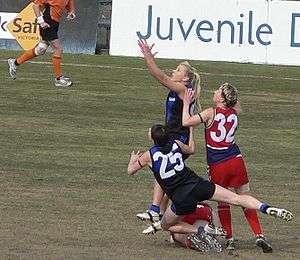
Melbourne University Sport offers access to a range of sporting clubs: aikido, athletics, badminton, baseball, basketball, boat, cheerleading, cricket, cycling, dancesport, dragon boat, fencing, men's football, women's football, futsal, gridiron, hockey, inline, karate, kendo, lacrosse, mountaineering, netball, quidditch, rugby union, skiing, snowboarding, soccer, softball, squash, surf riding, swimming, table tennis, taekwondo-rhee, taekwondo-wtf, taichi and wushu, tennis, touch football, underwater (SCUBA), ultimate frisbee, volleyball, water polo, waterski and wakeboard, and weightlifting and powerlifting.[195]
The Melbourne University Lacrosse Club (MULC) was established in 1883 and is the oldest continually operational lacrosse club in the world.[196] The Melbourne University Cycling Club (MUCyc) is associated with Cycling Australia and competes regularly at local and national races. In 2008 MUCyc won its seventh consecutive AUG championship (2002–2008).[197][198] The Melbourne University Tennis Club was one of the original five (5) clubs established for the students and staff of the university, with various tennis competitions and social tennis events held on campus as early as 1882.[199]
The facilities that The University of Melbourne offers include a gym, fitness programs, group fitness classes, cardio theatre, strength zone, group cycling studio, MindBody studio, Cardio Box studio, two multipurpose stadiums, indoor heated 25m lap pool, personal training studio, group fitness room, squash courts, and change rooms.[200]
Help and services
The University of Melbourne provides a full range of student services at Stop 1.[201]
People
Vice-chancellors
The following have led the university as its vice-chancellor:[202]
- Duncan Maskell: 1 October 2018 – present
- Glyn Davis: 10 January 2005 – 30 September 2018
- Kwong Lee Dow: 1 February 2004 – 9 January 2005
- Alan Gilbert: 1 January 1996 – 31 January 2004
- David Penington: 1 January 1988 – 31 December 1995
- David Caro: 1 June 1982 – 31 December 1987
- Sir David Derham: 1 March 1968 – 31 May 1982
- Sir George Paton: 1 July 1951 – 29 February 1968
- Sir John Medley: 1 July 1938 – 1 July 1951
- Sir Raymond Priestley: 1 January 1935 – 30 June 1938
- Sir James Barrett: 7 December 1931 – 17 December 1934
- Sir John Monash: 2 July 1923 – 8 October 1931
- Sir John Grice: 6 May 1918 – 18 June 1923
- Sir John MacFarland: 7 March 1910 – 8 April 1918
- Sir Henry Wrixon: 20 December 1897 – 7 March 1910
- Sir John Madden: 3 June 1889 – 20 December 1897
- Martin Irving: 2 May 1887 – 27 May 1889
- Sir Anthony Brownless: 31 May 1858 – 4 April 1887
- William Haines: 15 May 1857 – 31 May 1858
- Hugh Childers: 17 May 1853 – 12 March 1857
Nobel laureates
Many Nobel laureates have taught, studied and researched at the University of Melbourne. Graduates include:[203]
- Elizabeth Blackburn, Nobel Prize in Physiology or Medicine (2009)
- Sir John Eccles, Nobel Prize in Physiology or Medicine (1963)
- Sir Frank Macfarlane Burnet, Nobel Prize in Physiology or Medicine (1960)
- Joshua Lederberg, Nobel Prize in Physiology or Medicine (1958)
- Howard Florey, Nobel Prize in Physiology or Medicine (1945)
- Sir James Mirrlees, Nobel Prize in Economic Science (1996)
- Bert Sakmann, Nobel Prize in Physiology or Medicine (1991)
Notable alumni
The University of Melbourne has produced many notable alumni, with graduates having been Governor-General of Australia, Governor of Victoria, Prime Minister of Australia, justices of the High, Federal, Family and Victorian Supreme courts, Premiers of Victoria and elected leaders of other states and territories, Nobel Laureates, a First Lady of East Timor, ministers of foreign countries, Lord Mayors, academics, architects, historians, poets, philosophers, politicians, scientists, physicists, authors, industry leaders, defence force personnel, corporate leaders, community leaders, as well as numerous artists. Frances Dorothy Gray became Australia's first female Bachelor of Dental Science graduate When she graduated from the Australian College of Dentistry at the University of Melbourne in 1907.[204]
Gallery
 Clocktower at the Old Arts Building, viewed from South Lawn
Clocktower at the Old Arts Building, viewed from South Lawn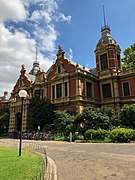 1888 Building, home to the Graduate Student Association
1888 Building, home to the Graduate Student Association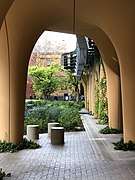 Arts West colonnade, 2018
Arts West colonnade, 2018.jpg) Melbourne School of Design, which incorporates the relocated facade of a Collins Street bank
Melbourne School of Design, which incorporates the relocated facade of a Collins Street bank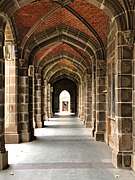 View down the colonnade on the Northern section of the Old Quad, the first building at the University of Melbourne
View down the colonnade on the Northern section of the Old Quad, the first building at the University of Melbourne Melba Hall and Conservatorium of Music
Melba Hall and Conservatorium of Music.jpg) Newman College Chapel
Newman College Chapel.jpg) Trinity College Chapel
Trinity College Chapel Entrance to South Lawn car park, originally from the Colonial Bank of Australasia headquarters in Melbourne city centre
Entrance to South Lawn car park, originally from the Colonial Bank of Australasia headquarters in Melbourne city centre Ian Potter Museum of Art, Swanston St
Ian Potter Museum of Art, Swanston St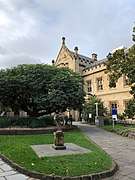 Cussonia Court
Cussonia Court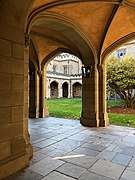 Southern colonnade, Old Quad
Southern colonnade, Old Quad- Botany Building (1928). Parkville Campus of The University of Melbourne
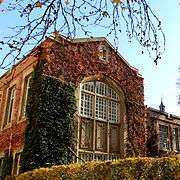 University of Melbourne in Autumn
University of Melbourne in Autumn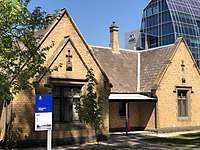 Gatekeeper's Cottage on Grattan Street
Gatekeeper's Cottage on Grattan Street
See also
- Centre of Excellence for Biosecurity Risk Analysis (CEBRA) - within the School of Biosciences
- List of universities in Australia
- NICTA – national information and communication technology research centre, co-supported by Melbourne University
- University of Melbourne Academic Dress
- Victorian School of Forestry
References
Citations
- University of Melbourne, University of Melbourne Calendar 1902 (Melbourne: Melville & Mullen, 1902), 403.
- University of Dublin, Records of the Tercententary Festival of the University of Dublin held 5th to 8th July, 1892 (Dublin: Hodges, Figgis, & Co., 1894), 174.
- University of Sydney,Record of the Jubilee Celebrations of the University of Sydney: September 30th, 1902 (Sydney: William Brooks and Co., 1903), 136.
- https://about.unimelb.edu.au/leadership/vice-chancellor/professor-duncan-maskell
- "2018 Annual Report" (PDF). University of Melbourne. Retrieved 31 August 2019.
- The University of Melbourne Campus. 4 January 2011. Retrieved 13 April 2016 – via YouTube.
- "Partner Universities". Washington University in St. Louis. Retrieved 4 August 2020.
- "About the University : Future Students". Futurestudents.unimelb.edu.au. Retrieved 17 January 2014.
- "McDonnell International Scholars Academy". Global. Retrieved 4 August 2019.
- "Melbourne University regarded top in the country, but reputation isn't everything". 15 March 2012. Retrieved 18 May 2013.
- "Australian Universities". Retrieved 18 May 2013.
- "Melbourne tops discipline based ranking". The Australian. 8 May 2013. Retrieved 19 May 2013.
- "World University Rankings 2020". THE World University Rankings 2017-2018.
- "Academic Ranking of World Universities 2019". Shanghai Ranking Consultancy.
- "QS World University Rankings 2021". Quacquarelli Symonds.
- "Research and industry leaders - Notable Staff and Alumni". about.unimelb.edu.au. Archived from the original on 27 April 2016. Retrieved 13 May 2016.
- "Bools of the Week". The Courier-Mail. Brisbane: National Library of Australia. 27 February 1937. p. 20. Retrieved 8 February 2012.
- "Melbourne University". The Argus. Melbourne: National Library of Australia. 1 September 1934. p. 6. Retrieved 8 February 2012.
- "Melbourne University". The Argus. Melbourne: National Library of Australia. 1 September 1934. p. 6. Retrieved 9 February 2012.
- "The University of Melbourne Timeline". Our History. The University of Melbourne. Retrieved 6 May 2019.
- Selleck, 2003
- Selleck 2003, p 164–165
- "The University of Melbourne Brand Story". Brand Hub. The University of Melbourne. Retrieved 6 May 2019.
- "The University of Melbourne 150th Anniversary". 10 February 2011. Archived from the original on 10 February 2011. Retrieved 17 October 2017.
- "Melbourne School of Land & Environment. Burnley Campus". Archived from the original on 2 January 2014. Retrieved 22 January 2014.
- "Melbourne School of Land & Environment. Creswick Campus". Archived from the original on 2 January 2014. Retrieved 22 January 2014.
- "Dookie". Dookie.unimelb.edu.au. Retrieved 17 January 2014.
- "Global MBA rankings 2006". Rankings.ft.com. Retrieved 17 January 2014.
- "Campuses : About the University : The University of Melbourne". www.unimelb.edu.au. Retrieved 7 September 2015.
- "Self-Guided Campus Tour - University of Melbourne" (PDF). University of Melbourne. Archived from the original (PDF) on 12 July 2013. Retrieved 7 September 2015.
- University of Melbourne. "Growing Esteem 2015-2020" (PDF). Retrieved 13 February 2017.
- "Your Life on Campus". The University of Melbourne. The University of Melbourne. Retrieved 6 May 2019.
- "Melbourne University website". Archived from the original on 12 April 2011. Retrieved 17 January 2014.
- "Melbourne University website". Archived from the original on 11 March 2011. Retrieved 17 January 2014.
- "Melbourne University website". Archived from the original on 12 April 2011. Retrieved 17 January 2014.
- "Melbourne University website". Archived from the original on 12 April 2011. Retrieved 17 January 2014.
- https://pursuit.unimelb.edu.au/articles/cris-jones-on-the-death-and-life-of-otto-bloom
- 21 May 2009, Accessed 19 July 2009
- "Archived copy". Archived from the original on 10 July 2009. Retrieved 18 July 2009.CS1 maint: archived copy as title (link) 5.5.R1 – The Faculty of The Victorian College of The Arts. Accessed 19 July 2009
- Pretty well rehearsed in reshaping the arts. 12 April 2009. Accessed 19 July 2009
- Arts college teachers up in arms. 16 July 2009, Accessed 19 July 2009
- 28 May 2009. Accessed 19 July 2009
- "Exciting new era for VCA as Premier announces details of $24 million funding package". Retrieved 23 January 2014.
- "VCA future bright thanks to $24million budget allocation". Retrieved 23 January 2014.
- "Southbank Campus Redevelopment". Faculty of Fine Arts and Music. The University of Melbourne. Retrieved 6 May 2019.
- "Burnley: School of Ecosystem and Forest Sciences". School of Ecosystem and Forest Sciences. The University of Melbourne. Retrieved 6 May 2019.
- "Creswick". School of Ecosystem and Forest Sciences. The University of Melbourne. Retrieved 6 May 2019.
- "Dookie Welcome". The University of Melbourne. The University of Melbourne. Retrieved 6 May 2019.
- "Shepparton Campus Accommodation". Going Rural Health. Going Rural Health. Retrieved 6 May 2019.
- "Shepparton Medical Centre". The University of Melbourne. The University of Melbourne. Retrieved 6 May 2019.
- "Werribee Redevelopment". Faculty of Veterinary and Agricultural Sciences. The University of Melbourne. Retrieved 6 May 2019.
- "Kendall Hall". Faculty of Veterinary and Agricultural Sciences. The University of Melbourne. Retrieved 6 May 2019.
- University of Melbourne Act 2009 (Vic)
- "Neo-Gothic Buildings (Searching) – Buildings [Walking Melbourne]". Walkingmelbourne.com. Retrieved 17 January 2014.
- "Regulatory Framework". About The University of Melbourne. The University of Melbourne. Retrieved 6 May 2019.
- "Peak Bodies and Structures". About The University of Melbourne. The University of Melbourne. Retrieved 6 May 2019.
- "University of Melbourne Investment Report 2013" (PDF). Retrieved 13 August 2014.
- Battered Melbourne Uni slashes 220 jobs, The Age, 29 July 2009
- https://umsu.unimelb.edu.au/farrago/inside-the-business-improvement-program/
- "Believe Campaign". The University of Melbourne. The University of Melbourne. Retrieved 6 May 2019.
- "About The University of Melbourne: Faculties and Graduate Schools". about.unimelb.edu.au. The University of Melbourne. Retrieved 6 May 2019.
- "Structure and Leadership". Melbourne Design School. The University of Melbourne. Retrieved 6 May 2019.
- "Leadership Faculty of Arts". Faculty of Arts. The University of Melbourne. Retrieved 6 May 2019.
- "Leadership Team". Faculty of Business and Economics. The University of Melbourne. Retrieved 6 May 2019.
- "Message from the Dean". Melbourne Graduate School of Education. The University of Melbourne. Retrieved 6 May 2019.
- "Dean's Welcome". Melbourne School of Engineering. The University of Melbourne. Retrieved 6 May 2019.
- "About". Faculty of Fine Arts and Music. The University of Melbourne. Retrieved 6 May 2019.
- "Melbourne Law School: Dean's Message". law.unimelb.edu.au. The University of Melbourne. Retrieved 6 May 2019.
- "Welcome". Faculty of Medicine, Dentistry and Health Sciences. The University of Melbourne. Retrieved 6 May 2019.
- "About Us". Faculty of Science. The University of Melbourne. Retrieved 6 May 2019.
- "Professor John Fazakerley announced as new FVAS Dean". The University of Melbourne. 24 February 2016. Retrieved 6 May 2019.
- "Faculties and Graduate Schools". Unimelb.edu.au. Retrieved 17 January 2014.
- Does this model have legs?, The Age, 15 August 2009.
- "University of Melbourne at a glance" (PDF). University of Melbourne. Retrieved 17 January 2014.
- "How You're Selected". The University of Melbourne. The University of Melbourne. Retrieved 7 May 2019.
- "Eligibility for Access Melbourne 2019". The University of Melbourne. The University of Melbourne. Retrieved 7 May 2019.
- "Guaranteed Entry Scores". The University of Melbourne. The University of Melbourne. Retrieved 7 May 2019.
- "Study in Melbourne, Australia – Courses at The University of Melbourne, Australia". unimelb.edu.au. Retrieved 13 April 2016.
- http://edsc.unimelb.edu.au/undergraduate/course-planning/sample-course-plans-bachelor-of-environments
- http://environment.unimelb.edu.au/
- Batterbury, S., & Toscano, M. (2018). Seeking Justice through Interdisciplinary Environmental Education at Postgraduate Level: Lessons from Melbourne, Australia. Revista Internacional de Educación para la Justicia Social, 7(1), 141-156.
- A matter of degrees, The Age, 14 April 2007
- Australian Qualifications Framework. First Edition July 2012. [Cited 2 July 2012] URL: http://www.aqf.edu.au/Portals/0/Documents/Handbook/AustQuals%20FrmwrkFirstEditionJuly2011_FINAL.pdf Archived 9 August 2012 at the Wayback Machine.
- "NTEU condemns University oF Melbourne's consultation sham over arts renewal strategy" Archived 29 July 2008 at the Wayback Machine National Tertiary Education Union, 10 July 2007. Accessed 3 May 2008
- "Cuts take toll on 'overworked' Melbourne Uni staff", The Age, 11 April 2008. Accessed 3 May 2008.
- What do budgets, Burnley and the housing crisis have in common? Archived 11 September 2008 at Archive.today President's Ponderings, 25 August 2008. Accessed 20 October 2008
- Vice Chancellor Lies About Introduction of Melbourne Model at VCA Archived 20 July 2008 at the Wayback Machine VCA Student Union, 29 April 2008. Accessed 3 May 2008
- 'Dreamlarge' a nightmare for the Arts Faculty Advocate, Volume 14, Number 2, July 2007. Accessed 26 October 2008
- "The Melbourne Model: The jury is still out", Advocate, Volume 14, Number 2, July 2007. Accessed 26 October 2008
- "Why the Melbourne Model is failing students", Eureka Street, 12 December 2008. Accessed 14 December 2008
- "Express yourself, but steer clear of politics" Archived 20 July 2008 at the Wayback Machine, The Age, 7 June 2008. Accessed 8 August 2008
- "QS World University Rankings 2021". Quacquarelli Symonds Limited.
- "World University Rankings 2020". TSL Education Limited.
- "Academic Ranking of World Universities 2019". Shanghai Ranking Consultancy.
- "U.S. News and World Report Best Global Universities Rankings". U.S. News and World Report.
- "CWTS Leiden Ranking 2017". Centre for Science and Technology Studies, Leiden University.
- "THE 2020 - Australia". Times Higher Education.
- "Academic Ranking of World Universities 2019 - Australia". Shanghai Ranking Consultancy.
- "U.S. News and World Report Best Global Universities in Australia/New Zealand". U.S. News and World Report.
- "Australian University Rankings". Australian Education Network.
- "World University Rankings 2017-2018". THE World University Rankings 2017-2018.
- "QS World University Rankings 2019". Quacquarelli Symonds. 2018.
- "SCImago Institutions Rankings - Higher Education - All Regions and Countries - 2019 - Overall Rank". www.scimagoir.com.
- "CWTS Leiden Ranking 2018". CWTS Leiden.
- "Academic Ranking of World Universities 2018". Shanghai Ranking Consultancy.
- "QS World University Subject Rankings 2015". QS World University Rankings. 2015.
- "Bachelor of Arts". unimelb.edu.au. Retrieved 13 April 2016.
- "2013 Graduate Prospectus". Bpointelligence.com. Archived from the original on 29 October 2013. Retrieved 17 January 2014.
- "Our Research Strategy'". The University of Melbourne. The University of Melbourne. Retrieved 7 May 2019.
- "World University Rankings". NTU Ranking. National Taiwan University. Retrieved 7 May 2019.
- "Introduction". NTU Ranking'. National Taiwan University. Retrieved 7 May 2019.
- "About CWUR". CWUR. The Center for World University Rankings. Retrieved 7 May 2019.
- "Top Universities - Australia". CWUR. The Center for World University Rankings. Retrieved 7 May 2019.
- "Our Reputation and Rankings". The University of Melbourne. The University of Melbourne. Retrieved 7 May 2019.
- "Annual Report 2010" (PDF). University of Melbourne. Retrieved 31 July 2016.
- "International Postgraduate Research Scholarships (IPRS)". Innovation.gov.au. Retrieved 17 January 2014.
- "University of Melbourne Annual Report 2010" (PDF). Retrieved 17 January 2014.
- "Melbourne Entrepreneurial Centre". The University of Melbourne. The University of Melbourne. Retrieved 7 May 2019.
- "About The Melbourne Entrepreneurial Centre". The University of Melbourne. The University of Melbourne. Retrieved 7 May 2019.
- "Melbourne Accelerator Program". Melbourne University Engineering Department. Archived from the original on 24 November 2014. Retrieved 21 November 2014.
- "Two Australian university accelerators named in global top 25 list". Startup Smart Australia. Retrieved 21 November 2014.
- "Bluesky Homepage". Bluesky. Retrieved 21 November 2014.
- "121Cast Homepage". 121Cast. Retrieved 21 November 2014.
- "VenueMob Homepage". Venuemob. Retrieved 21 November 2014.
- "Meet the Finalists of the StarTrack Online Retail Industry Awards 2014". PowerRetail. Retrieved 21 November 2014.
- "Audio app Omny scores content partnership with Southern Cross Austereo". Startup Smart Australia. Retrieved 21 November 2014.
- "About the Melbourne Accelerator Program". Melbourne University Engineering Department. Archived from the original on 29 November 2014. Retrieved 21 November 2014.
- "TRAM FAQ". Melbourne Connect. The University of Melbourne. Retrieved 7 May 2019.
- "Wade Institute". Wade Institute of Entrepreneurship. Wade Institute of Entrepreneurship. Retrieved 7 May 2019.
- About Us – Library, University of Melbourne website
- "Architecture, Building and Planning Library". The University of Melbourne. The University of Melbourne. Retrieved 7 May 2019.
- "Baillieu Library". The University of Melbourne. The University of Melbourne. Retrieved 25 July 2019.
- "Services: Library". The University of Melbourne. The University of Melbourne. Retrieved 7 May 2019.
- "Veterinary and Agricultural Sciences Libraries". The University of Melbourne. The University of Melbourne. Retrieved 7 May 2019.
- "Burnley: Library". The University of Melbourne. The University of Melbourne. Retrieved 7 May 2019.
- "Collections: Burnley Library". The University of Melbourne. The University of Melbourne. Retrieved 7 May 2019.
- "Services: Burnley Library". The University of Melbourne. The University of Melbourne. Retrieved 7 May 2019.
- "Dookie: Library". The University of Melbourne. The University of Melbourne. Retrieved 7 May 2019.
- "Collections: Dookie Library". The University of Melbourne. The University of Melbourne. Retrieved 7 May 2019.
- "Services: Dookie Library". The University of Melbourne. The University of Melbourne. Retrieved 7 May 2019.
- "Eastern Resource Centre: Library". The University of Melbourne. The University of Melbourne. Retrieved 7 May 2019.
- "Collections Overview: ERC Library". The University of Melbourne. The University of Melbourne. Retrieved 7 May 2019.
- "Veterinary and Agricultural Science Libraries". library.unimelb.edu.au. The University of Melbourne. Retrieved 7 May 2019.
- "Services: ERC Library". The University of Melbourne. The University of Melbourne. Retrieved 7 May 2019.
- "Giblin Eunson Library". The University of Melbourne. The University of Melbourne. Retrieved 7 May 2019.
- "Services at the Giblin Eunson Library". The University of Melbourne. The University of Melbourne. Retrieved 7 May 2019.
- "Education Collections: Giblin Eunson Library". The University of Melbourne. The University of Melbourne. Retrieved 7 May 2019.
- "Business and Economics Research Databases". The University of Melbourne. The University of Melbourne. Retrieved 7 May 2019.
- "Law Library About". The University of Melbourne. The University of Melbourne. Retrieved 7 May 2019.
- "Law Library Collections". The University of Melbourne. The University of Melbourne. Retrieved 7 May 2019.
- "Law Library Research Tools". The University of Melbourne. The University of Melbourne. Retrieved 7 May 2019.
- "Creswick Library". The University of Melbourne. The University of Melbourne. Retrieved 7 May 2019.
- "Services: Creswick Library". The University of Melbourne. The University of Melbourne. Retrieved 7 May 2019.
- "Collections: Creswick Library". The University of Melbourne. The University of Melbourne. Retrieved 7 May 2019.
- "Southbank Library". The University of Melbourne. The University of Melbourne. Retrieved 7 May 2019.
- "Southbank Hub: Students". The University of Melbourne. The University of Melbourne. Retrieved 7 May 2019.
- "Services: Southbank Library". The University of Melbourne. The University of Melbourne. Retrieved 7 May 2019.
- "Werribee: Library". The University of Melbourne. The University of Melbourne. Retrieved 7 May 2019.
- "Services: Werribee Library". The University of Melbourne. The University of Melbourne. Retrieved 7 May 2019.
- "Grainger Museum". The University of Melbourne. The University of Melbourne. Retrieved 7 May 2019.
- "Harry Brookes Allen Museum of Anatomy and Pathology". The University of Melbourne. The University of Melbourne. Retrieved 7 May 2019.
- "Henry Forman Atkinson Dental Museum". The University of Melbourne. The University of Melbourne. Retrieved 7 May 2019.
- "The Ian Potter Museum of Art". The University of Melbourne. The University of Melbourne. Retrieved 7 May 2019.
- "Margaret Lawrence Gallery". The University of Melbourne. The University of Melbourne. Retrieved 7 May 2019.
- "Medical History Museum". The University of Melbourne. The University of Melbourne. Retrieved 7 May 2019.
- "Noel Shaw Gallery". The University of Melbourne. Retrieved 7 May 2019.
- "Ed Muirhead Physics Museum". The University of Melbourne. The University of Melbourne. Retrieved 7 May 2019.
- "The Dax Centre: About Us". The Dax Centre. The Dax Centre. Retrieved 7 May 2019.
- "Tiegs Museum". The University of Melbourne. The University of Melbourne. Retrieved 7 May 2019.
- "About Buxton Contemporary". Buxton Contemporary. Buxton Contemporary. Retrieved 7 May 2019.
- "Melbourne Science Gallery". Science Gallery. Science Gallery. Retrieved 7 May 2019.
- "Why Live in a College? — Residential Colleges of the University of Melbourne". Colleges.unimelb.edu.au. Retrieved 17 January 2014.
- "Graduate House". Graduate House. Graduate House The University of Melbourne. Retrieved 7 May 2019.
- Lindsay, Nicole (3 August 2017). "More beds on Royal Parade for students". The Sydney Morning Herald. Retrieved 7 May 2019.
- "Ridley College History". Ridley College. Ridley College. Retrieved 7 May 2019.
- "Student clubs, societies and communities". The University of Melbourne. The University of Melbourne. Retrieved 7 May 2019.
- "UMSU Clubs". UMSU. University of Melbourne Student Union. Retrieved 7 May 2019.
- "Grad Groups University of Melbourne". GSA. Graduate Student Association. Retrieved 7 May 2019.
- "UMSU Arts Students Society (M-ASS)". UMSU. University of Melbourne Student Union. Retrieved 7 May 2019.
- "Faculty of Business and Economics Clubs and Societies". The University of Melbourne. The University of Melbourne. Retrieved 7 May 2019.
- "Environments and Design Students Clubs and Societies". The University of Melbourne. The University of Melbourne. Retrieved 7 May 2019.
- "Student Enrichment Faculty of Medicine, Dentistry and Health Sciences". The University of Melbourne. The University of Melbourne. Retrieved 7 May 2019.
- "Student Clubs and Societies Faculty of Science". The University of Melbourne. The University of Melbourne. Retrieved 7 May 2019.
- "Student Life and Societies: Melbourne Law School". The University of Melbourne. The University of Melbourne. Retrieved 7 May 2019.
- "UMSU History". UMSU. University of Melbourne Student Union. Retrieved 7 May 2019.
- "UMSU A bit about us". UMSU. University of Melbourne Student Union. Retrieved 7 May 2019.
- "About Graduate Student Association". GSA. University of Melbourne Graduate Student Association. Retrieved 7 May 2019.
- "UMSU Queer". UMSU. University of Melbourne Student Union. Retrieved 7 May 2019.
- "UMSU Disabilities Department". UMSU. University of Melbourne Student Union. Retrieved 7 May 2019.
- "Murrup Barak Strategic Statement and Service Offer" (PDF). The University of Melbourne. The University of Melbourne. Retrieved 7 May 2019.
- "Indigenous Student Outreach". The University of Melbourne. The University of Melbourne. Retrieved 7 May 2019.
- "The Student Success Team: Murrup Barak". The University of Melbourne. The University of Melbourne. Retrieved 7 May 2019.
- "About MU Sport". The University of Melbourne. The University of Melbourne. Retrieved 7 May 2019.
- "MU Sport FAQ's". The University of Melbourne. The University of Melbourne. Retrieved 7 May 2019.
- "Melbourne University Sport Clubs". The University of Melbourne. The University of Melbourne. Retrieved 7 May 2019.
- "Melbourne University Lacrosse Club". Mulax.org. Retrieved 17 January 2014.
- Warnecke R., "Team Melbourne wins record haul at Uni Games" Archived 6 April 2009 at the Wayback Machine, University sports news and events
- Warnecke, Rod "Gold Rush At Uni Games", University of Melbourne Voice, 10 November 2008
- "Home : Museums and Collections" (PDF). unimelb.edu.au. Retrieved 13 April 2016.
- "Melbourne University Sport Facilities". The University of Melbourne. The University of Melbourne. Retrieved 7 May 2019.
- "Stop 1: Connecting students and services". students.unimelb.edu.au. 3 December 2015. Retrieved 19 September 2019.
- "Past Vice-Chancellors". About The University of Melbourne. The University of Melbourne. Retrieved 9 May 2019.
- "Research and Industry Leaders". The University of Melbourne. The University of Melbourne. Retrieved 7 May 2019.
- "I Am Woman…Hear Us Roar…and See Us Do Teeth!". thesmilecenterusa.com/. 1 March 2013. Archived from the original on 18 December 2014. Retrieved 29 May 2013.
Sources
- Books
- Macintyre, S. & Selleck, R.J.W. (2003). A short history of the University of Melbourne. Melbourne: Melbourne University Press. ISBN 0-522-85058-8.
- Selleck, R.J.W. (2003). The Shop: The University of Melbourne, 1850–1939. Melbourne: University of Melbourne Press. 930pp
- Poynter, John & Rasmussen, Carolyn (1996). A Place Apart – The University of Melbourne: Decades of Challenge. Melbourne: Melbourne University Press. ISBN 0-522-84584-3.
- Cain J II and J Hewitt. (2004). Off Course: From Public Place to Marketplace at Melbourne University. Melbourne: Scribe. review
- Newspaper
- McPhee, P. 2005. "From the Acting Vice-Chancellor." Uni News. The University of Melbourne. 03/10/05, p. 3.
External links
| Wikimedia Commons has media related to University of Melbourne. |